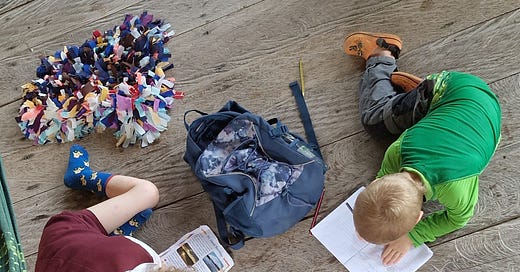Excerpt from hypothetical diary of Guenevere Bradbury (Aged 31¼):
Feb 13, 2018 (UK: Shrove Tuesday) - Rained on-and-off all day. Had pancakes. So many pancakes. P.S. Challenged Greg to give up chairs for Lent this year. He has counter-challenged me (as his right), so that’s happening. Apparently.
Feb 14, 2018 - First day of Lent - Rained on-and-off all day again. Noodles for dinner, but on the floor obviously (!). We used the spare shelf board as a table. Stayed on the floor to watch Jonathan Creek. Feels a bit spartan, but not the end of the world. Also borrowed one of the standing desks at work and they don’t mind if I kneel at the table instead of sit for lunch. No worries about this - got Lent in the bag!
Feb 15, 2018 - Second day of Lent - I need to not tempt fate ever again. Even in writing. I could not have been more wrong: everything hurts. Everything! Legs, back, arms, shoulders, wrists, neck. Neck!? What has sitting on the floor got to do with my neck? Sofa has its own gravitational pull. I can feel it calling me. But I need to not be the person who fails first, dammit. Rain stopped though, so that’s nice.
Feb 16, 2018 - Third day of Lent - Ow. Owwwww. Send help. Or an ice pack. Ow…
[Complaining continues for weeks].
Mar 31, 2018 - Last day of Lent - Looking forward to Easter tomorrow! I’ve just flicked back to read the pages from six weeks ago. I was really complaining a lot! It doesn’t hurt at all now: no stiffness, better flexibility, no pain at all. In fact, getting up has never been easier. How weak was I that I couldn’t even handle sitting on the floor?
The above isn’t a piece of my diary. That’s not because this isn’t *exactly* how it happened. It’s just that my real-world log-book reads like a cross between a shopping list and the shipping forecast. This, however, is absolutely true to life: I spent Easter 2018 quietly stunned, trying to work out how sitting on chairs could have made us so unfit.
Chairs are a very recent part of our homes
Chairs. It feels odd to think of chairs as a recent WEIRD invention (WEIRD = cultures that are Western, Educated, Industrialised, Rich, and Democratic). Until I looked into it, I imagined people had always used chairs - that Neolithic woman, after a long day of later-uncredited mammoth hunting, would flop into her favourite chair (made, I had imagined, out of the hides of hunts past), and put her feet up for just a while.
It turns out I was completely wrong. While there is evidence of special ceremonial chairs for chiefs and leaders dating back 5000 years, chairs only made it into the houses of us commoners about 200 years ago. In about eight generations, we've gone from never sitting in a chair to slumping in one for an average of 6.5 hours each day (unless you’re an adolescent, when it’s even more).
But chairs completely change how we rest.
Sitting on the floor is a whole-body activity
Let’s start by thinking about the workout that is sitting on the floor. It’s a routine of three parts:
Getting down to the floor: Depending on the strength, length, and balance of your muscles, getting down to the floor looks like anything from a controlled deep squat to a flop. It requires your hips, knees, and ankles to flex fully, slowing your descent so you land comfortably on your buttocks.
Sitting on the floor: This requires that you can arrange your limbs in a way that you can put most of your weight through your sit bones - the ischial tuberosities on your pelvis. There are many flavours of sitting on the floor - the cross legged, the lotus, the straight-legged, the Z-sit, the W-sit, and many more. They're all comfortable, but none for longer than about 20 minutes.
So, soon-ish, you have to change position: even the thickest, most luxuriant carpet doesn’t compare to the comfort of the soft padded butt-receptacle presented by a typical chair. Shifting position, even a little, provides different loads and different stretches on body tissues. Sitting without chairs may be stationary, but isn't what we know as sedentary.
And hey, once you’re down there, it’s very easy to get into non-sit positions. Fancy squatting, crouching, or kneeling? Or maybe you want to lie down, or take a second in child’s pose. People who floor-sit tend to rest in non-sit positions too.
Getting up from the floor: Finally, what’s down must come up! Getting up from the floor is much harder than getting up from a chair. Standing up from a chair is a doddle. You're already halfway standing anyway, and the top half of that journey is the easy half! Standing up from the floor is a whole different thing. It's a whole body exercise involving not just legs, but also hips, abs, and usually arms and shoulders.
Sitting in a chair is much more sedentary
OK, let’s compare floor-sitting to chair sitting:
Getting down to the chair: Imagine getting down to the floor, but stopping halfway. And it’s the much easier half because your joints aren’t flexed. You’re only using the strongest bits of your muscles
Sitting on the chair:
Position: Not all chairs hold the ankles, knees, and hips at a fixed angle (normally about 90 degrees), but the vast majority do. This is not a position people assume much without chairs.
Support: Instead of weight going down through the bony tuberosities, chair sitting puts the weight down through major muscle groups (glutes, hamstrings and lower back).
Shifting position: Why would you want to? With the weight transmitting through the major muscle groups, the skin feels much lower pressures and never gets uncomfortable enough to trigger a shift. Also, even if you want to, most chairs are built for only one position.
Adopting completely different positions: It’s certainly possible to swivel the chair round and lean against the back like a rebellious teenager. But squatting or crouching are hard when you’ve got a desk up to your belly, and you’re worrying about the H&S consequences when your squatting overcomes the chair stability.
Getting up from the chair: Well, you’re halfway up already. This means you’re only using half of the muscles’ ranges of motion, which will (over time) reduce the range of strength. And, unless you’re really feeling the weight of the world, most of us don’t need to even contemplate using our arms to get out of a chair. We can save those for the important activities of swiping and typing.
While both are restful, floor sitting ≠ chair sitting. It’s a very different proposition.
Floor-sitting is even more vital for children
So, sitting on the floor is a fantastic way to build more movement into our lives. As adults, that is useful, . For children, it’s absolutely crucial. We know that children in our culture are far, far weaker than their grandparents and even their parents were at their age. You can think about movement as as much of a ‘nutrient’ as vitamins and minerals, it’s as useful to growth and development. And fear of letting children get dirty, have time alone outside, and of judgement from other parents means that most children are growing up profoundly deficient in movement nutrients.
Parentification or infantilisation?
We need children to move more, but it's hard in a WEIRD culture. We're so focused on protecting in the short-term that we forget we need to protect them in the long-term too. But there are things we can do...
Which is why getting kids sitting on the floor is such a powerful way to improve their health and fitness. When the baseline is so low, even small interventions have enormous power to change things. And as my partner and I can assure you, sitting on the floor is a deceptively big movement intervention.
Putting children in straitjackets
Of course, in order to have children who sit on the floor, we need to make sure that their clothes allow them to do so. But this isn't always as easy as we think...
Getting up from the floor 20-40 times each day doesn't sound like much, but it uses parts of muscles that we rarely use for anything else. Exercising these parts of our muscles in childhood sets us up for increased strength and reduced injury risk as adults. Especially in the shoulders and back.

(NB. This is especially important for our child with a disability. To return to our ‘nutrients’ analogy: Her body is less efficient at using movement nutrients, and so she needs more but getting them is harder. Physiotherapy exercises are uninspiring and hard to remember, but it’s inescapable that there aren’t any chairs in the house. Floor-sitting is even more useful for children with extra challenges, because you don’t need to enforce movement or exercise when the alternative is just not possible).
We can incentivise floor-sitting in lots of ways
Fortunately, once we’ve got past the aches and pains, floor-sitting is intrinsically fun. It’s playful, it’s cheap, and it gets you on the same level as your kids. So what can we do to help children spend more of their stationary time on the floor?
Remove chairs: Having no chairs is the BEST way to reduce chair-sitting. Take a look around your home. How many chairs do you own? How many of those are only designed for children? Does your kid need their own tiny chairs and tables? How would they move differently without them?
Make non-chair parts of the room more appealing. Got a radiator or an infra-red heater? Make sure there are no chairs right in front of it. Why not put some floor cushions in front of the TV and put the sofa elsewhere?
Have floor picnics. In the Amerindian villages in which we lived, they used a ‘ground table’ - a mat. Everything tastes better when it’s eaten picnic style [reference pending]. Except possibly steak and chips - there’s a reason that most dining-on-the-floor cultures don’t mandate knife and fork use for large chunks of chewy meat. In fact, most cultures that eat on the floor use either their hands (often from a central dish) or use tools that they can hold in just one hand so they can hold a bowl in the other.
Model it. As I’ve talked about so many times in my book, Growing up WEIRD, one of the most powerful things we can do to change how our children behave is to show them, not tell them, what we should do. So save money on your gym membership and start sitting on the floor!
And as for us in 2018? After our forty-day-and-forty-night experiment, my partner and I decided that we couldn’t afford to outsource so much movement to our chairs. We didn’t have time to replace the movement it was giving us in any other way. So, we doubled down: during COVID, we put our dining table in the garage, got a few folding chairs so we had something to offer visitors, and got rid of the rest.
The notes above give some ideas for reducing the amount of time chair-sitting. I’m sure you can think of many more. Maybe Lent is the right driver for your family too? Get creative with it and you’ll soon see the rewards! Good luck. You’ll find something that sticks!
Oh, and in 2025, for me, it’s still sticking. At a recent workshop, we ended up sitting on the floor in a group.
“Your posture is amazing!’ whispered the person next to me. “Do you do Pilates?”
“No,” I replied. “I’m just good at sitting on the floor”.
Many people notice the effort required to sit on the floor when they have young children, who, (spoiler alert) spend much of their time on the floor. What drives you to sit on the floor?
Notes
History of chairs: Now I Sit Me Down: From Klismos to Plastic Chair: A Natural History by Witold Rybczynski. Published by Farrar, Straus and Giroux, LLC.
Average length of time sitting: https://jamanetwork.com/journals/jama/fullarticle/2731178







I work in a nursery! So there's no access to adult sized chairs 9 hours a day, 4 days a week. The stupid tiny wooden ones just hurt so Id rather sit on the floor all day. I sit on the floor at home now too! I wish I could eat on the floor but I have 4 dogs, not sure how that would go...
I've dreamed of doing this, but there's no way my wife would go for it. Also, the floor is the dog's domain, so it's impossible to keep it free of dirt and hair brought in with him from walks. I do sit on the floor quite a lot, but not as much as I would like. Your floor-sitting Lent journal is a strange thing to envy, but I do :-)